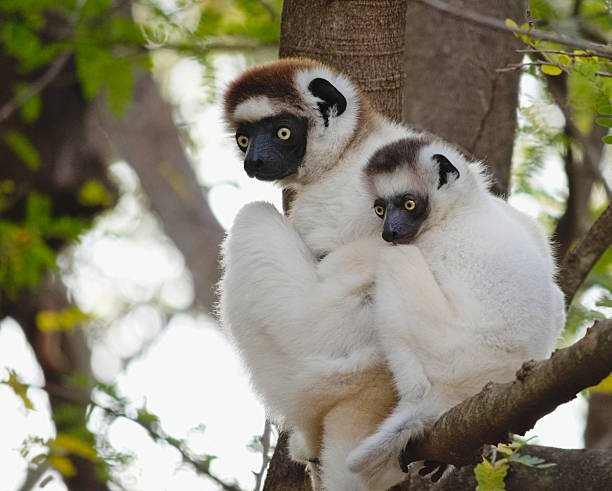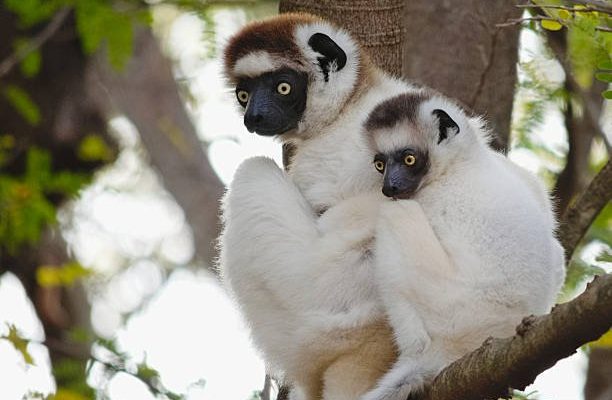
Now, raising a little one in the wild is no small feat. Picture it like trying to build a treehouse without instructions while watching over a hyper puppy—it’s a blend of instinct, strategy, and a lot of love. In this article, we’ll explore how sifakas approach parenting, from their social structures to the unique bond between mother and infant. Let’s dive into the world of these fascinating creatures and understand the rhythm of their family life in the wild.
The Sifaka Family Structure
Sifakas are social animals that typically live in small family groups. These groups can consist of a few adults and their offspring. The social structure is essential for the rearing of young sifakas. Generally, it’s the females that do most of the caregiving, while males help protect the group.
In a typical sifaka family, you might find a dominant female leading the group. This isn’t unlike how some human families might have a matriarch who sets the tone and makes decisions. The strong bonds within the family are crucial, especially because raising young sifakas requires cooperation and support from all members.
These family units also help in teaching the young ones about their surroundings. With siblings and other adults around, baby sifakas learn important skills like foraging for food and navigating through the trees. They gain valuable lessons by observing and mimicking the adults, much like kids learn by watching their parents at home.
The Role of the Mother Sifaka
The mother sifaka is at the center of the nurturing process. After a gestation period of about five months, she gives birth to a single infant, although twins can occur occasionally. The bond between mother and infant is strong from the very beginning.
Immediately after birth, the mother will hold her infant close, using her body warmth to keep the little one safe and cozy. It’s not just about physical care; this closeness helps establish a deep emotional connection. The mother communicates with her baby through sounds and even facial expressions, teaching the young sifaka how to interact with other members of the group.
As the baby grows, the mother gradually introduces them to solid foods, usually starting with fruits and leaves. She performs an interesting dance of sorts, picking up food pieces and showing them to her infant. You might picture a human parent waving a cookie in front of their child to entice them to try it—this is how mother sifakas share their diet with their young.
Learning Through Play
Play is a crucial part of a young sifaka’s development. Just like human children, baby sifakas spend a lot of time playing. This isn’t just for fun; it’s how they learn important life skills. Through rough-and-tumble games with siblings and other young ones, they practice climbing, jumping, and even social interaction.
During these play sessions, they also learn about their environment. They discover which trees are safe to leap from and where to find the tastiest leaves. It’s through this playful exploration that they gain confidence and the physical abilities they need to thrive in the wild.
You might have seen videos of young animals playing and thought it was just cute—while it is certainly adorable, it serves a much deeper purpose. For sifakas, this playtime helps them build the skills they’ll rely on later in life, making it a critical part of their upbringing.
Sibling Dynamics
In a sifaka family, siblings play an integral role in each other’s upbringing. Older siblings often help care for the younger ones, much like a big brother or sister might help with a new baby at home. This support system fosters a sense of teamwork within the family group.
The interaction between siblings can be a wonderful mix of nurturing and rivalry. Older sifakas engage younger ones by inviting them to play, which provides an opportunity for bonding and learning. At the same time, there might be little squabbles over food or space, which is completely normal. These interactions help them develop social skills that will be invaluable when they grow up and eventually start their own families.
As they learn to navigate these sibling dynamics, they also learn about sharing, cooperation, and conflict resolution—skills that are as important in the wild as they are in human life.
Protection and Safety
Keeping young sifakas safe in the wild is a shared responsibility. The entire family unit pitches in to protect the little ones from predators. Mother sifakas are particularly vigilant and have a keen sense of danger. If they sense a threat, they will often change their location or call for help from other group members.
Adult sifakas will take turns watching the young while others forage for food. It’s kind of like a well-coordinated team—everyone has a role to play. This vigilance enhances the survival chances of the young sifakas, allowing them to grow in a safe environment.
Interestingly, the young sifakas also contribute to their own safety as they grow. They learn how to hide and climb quickly, which are vital skills for escape. While their parents provide almost constant protection, independence is gradually encouraged, helping them develop resilience and alertness to potential threats.
Transitioning to Independence
As the young sifakas approach maturity, there comes a time for them to step out of their mother’s shadow. This transition to independence is significant and often involves a mix of excitement and anxiety for both the young sifakas and their parents.
Mother sifakas begin to encourage their young to try things on their own. They’ll let them forage with minimal supervision and take more risks in their play. This is similar to how parents might gradually give their teenagers more freedom, allowing them to make their own choices while still being there to offer guidance.
Eventually, young sifakas leave their maternal group to join other groups or form their own families. This move is a natural part of their life cycle and helps keep genetic diversity alive—an important aspect for the health of the species.
The Impact of Habitat Loss on Raising Young
Unfortunately, the challenges of raising young sifakas haven’t just remained in their natural habitat. Due to habitat loss and environmental changes, many sifaka families are facing tough times. Deforestation for agriculture and urban development affects their living spaces and food sources.
As they find it harder to raise young in safe environments, the survival rates of the offspring can drop. This is a big concern for conservationists, who work tirelessly to protect these marvelous creatures. Programs aimed at habitat restoration and protection are vital for the future of sifakas and their unique way of life.
In the face of these challenges, it’s important to increase awareness and support conservation efforts. Understanding how sifakas raise their young in the wild can help us appreciate their vulnerabilities and the necessity of preserving their habitats for generations to come.
So there you have it! The journey of how sifakas raise their young is a beautiful blend of instinct, social interaction, and the tight-knit bonds of family. From dedicated mothers to playful siblings and a community that bands together, these lemurs showcase the importance of cooperation and care in survival.
Understanding their parenting style not only highlights the complexities of their lives but also emphasizes the need for conservation efforts. As we learn more about these amazing creatures, we’re reminded of the delicate balance of nature and how every action we take can impact the future of species like the sifaka. By supporting their habitats, we’re ultimately helping to ensure that the rhythm of their family life continues for years to come.

